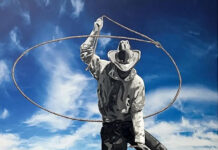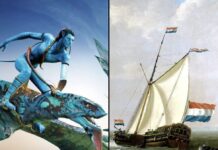“Oh, I loved the butterfly!” a guest exclaims at the end of the tour as the docent’s palm slams her forehead. “Damn pests!” the farmer would try to shout over the muffling biplane engine coating the cornfield with pesticides. “Is that a beetle?” I silently asked myself when the painting entered my field of vision. The simple answer to all these questions is no, revealing the unsurprisingly low amount of times we ruminate on insects. Unless the viewer happened to be a biology student that frantically crammed at 1:00 A.M. this morning for an entomology quiz, they probably would have failed to recognize the identity of this obscure bug. In an attempt to transform Jesuit’s outlook towards insects, British artist Sarah Graham presents the Jesuit Dallas Museum with a lithograph of Salvazana imperialis, a vibrantly-colored cicada.
Originally from Thailand, the mostly unknown cicada Salvazana imperialis (no known common name) spreads its twelve inch wingspan to reveal a hot-colored explosion of orange and yellow. During flight, this vibrant array of colors refreshes the eyes, a new perspective from Salva’s drab, black head and abdomen. The abdomen bulges out of the body, corrugated into multiple fine ridges that, when buckled 300 to 400 times per second, rumble to boom the of its rattling chirp. The leg of the cicada, lanky and astonishingly sturdy enough to uphold the fat abdomen, angularly curves and forks into a duo of microscopic claws. On opposite side of Salva, two antennae protrude out of its forehead in a wavy manner, frequently alternating the texture of the exoskeleton to finally arch inward and conclude with a narrow point. Unlike the mundanely black head and abdomen, the thorax shines bright with its silver gloss, once more offering a fresh contrast to the rest of the body.
While the entomologists and biologists have the role of identifying and explaining the body parts of insects and their basic functions like the thorax and abdomen, the artist enhances their work with bringing out those parts in greater detail. This symbiotic relationship between “museum quality art and scientific programming,” as the Jesuit Dallas Museum explained, allowed for an even more stunning relationship. In 2014, the Jesuit Dallas Museum partnered with the Perot Museum of Nature and Science so that this lithograph of Salvazana imperialis could display its colorful wingspan to the patrons of the Perot Museum. Having succeeded at the museum, Sarah Graham’s work has now returned home for the Jesuit students to experience.
In general, the public outlook towards cicadas, similar to many bugs, is an “ew” feeling. In this instance, the experience with a cicada up close causes a cringe reaction, both legs and arms instantaneously retracted towards the torso, a position many have not expressed ever since the time as a fetus. Therefore, unless the viewer were an entomologist or an insect aficionado desiring to confront cicadas for an image on the Insect Lovers Tumblr page, they would probably negatively perceive this insect. However, Graham’s lithograph seems to be altering the negative outlook, a new perspective from a pest to a pleasure. “It’s a beautiful rendition,” director Mrs. Elizabeth Hunt Blanc said. “The enormous size and expanse of it is a completely new way of looking at the bug.” Indeed, the up-close lithograph offers minute details such as the intricate wing pattern and luminous orange pair of eyes to stand out by pleasant means. Alex Motter ’16 remarked on the topic, “I think with the negative connotation that comes with cicadas, this is not the type of painting that you would expect from that (the cicada).” However, in his own image, “It creates beauty in something people will typically se as ugly.”






